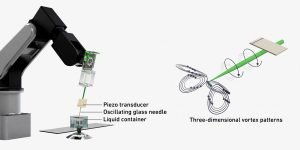Robots are often equipped with moving arms, many times programmed and used to carry out a variety of tasks in factories. These types of robots have traditionally had little association with miniature systems that transport small amounts of liquid through fine capillaries. These systems, known as microfluidics or lab-on-a-chip, usually use external pumps to move liquid through the chips. However, they have traditionally proved difficult to automate, and the chips need to be custom-designed and manufactured to each specific application.
But now, a team of researchers led by ETH Professor Daniel Ahmed are combining conventional robotics and microfluidics. The newly developed device uses ultrasound and can be attached to a robotic arm. It can also carry out a wide range of tasks in micro robotic and micro fluidic applications or used to automate these applications.
The new research was reported in Nature Communications.
New and Unique Device
The researchers have developed a unique device capable of creating three-dimensional vortex patterns in liquid through the use of oscillating glass needles powered by piezoelectric transducers – devices which are also found in loudspeakers, ultrasound imaging and dental cleaning tools. By adjusting the frequency of these oscillations, they can precisely control their pattern formations.

Image: ETH Zurich
The team used the device to demonstrate several applications, such as mixing tiny droplets of highly viscous liquids.
“The more viscous liquids are, the more difficult it is to mix them,” Ahmed says. “However, our method suceeds in doing this because it allows us to not only create a single vortex, but to also efficiently mix the liquids using a complex three-dimensional pattern composed of multiple strong vortices.”
By carefully manipulating vortices and positioning the oscillating glass needle near the channel wall, the scientists were also able to power their mini-channel system with astonishing efficiency.
By utilizing a robot-assisted acoustic device, they were able to efficiently capture fine particles in fluid. The size of each particle determined its reaction to sound waves, causing larger ones to accumulate around an oscillating glass needle. Remarkably, this same technique was shown capable not only of trapping inert particulates but also entire fish embryos. With further development, the method could be used for capturing biological cells from within fluids as well.
“In the past, manipulating microscopic particles in three dimensions was always challenging. Our microrobotic arm makes it easy,” Ahmed says.
“Until now, advancements in large, conventional robotics and microfluidic applications have been made separately,” Ahmed continues. “Our work helps to bring the two approaches together.

Vortex patterns in liquids Image: ETH Zurich
As we progress forward, microfluidic systems of the future could come close to rivaling that of today’s advanced robotic technology. By programming a single device with multiple tasks such as mixing and pumping liquids and trapping particles, Ahmed foresees us ushering in an age where custom-developed chips are no longer necessary for each application. Building upon this concept further is the idea to connect various glass needles together into intricate vortex patterns – pushing our capabilities beyond what was imaginable before.
Ahmed envisions an array of potential uses for microrobotic arms beyond the realm of laboratory analysis- anything from object sorting and DNA manipulation to additive manufacturing techniques like 3D printing. With these developments, we can revolutionize biotechnology as we know it.
Credit: Source link





















